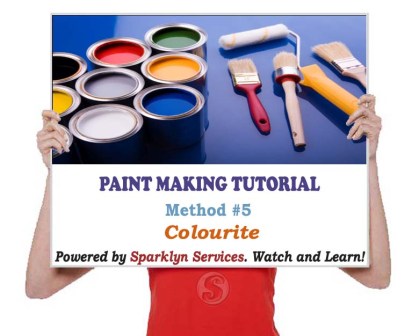PAINT MAKING TUTORIAL
Colourite
Post by Sparklyn, 10-Jan-2025.

This is the most important of the entire course. It involves the ability of mixing some colours to get a desired result. It is not difficult at all if you have initiative and artistic eye. These are the colours we have in raw form ( please permit me to call them primary colours because all other colours in the painting industry is gotten from them)
They are: yellow ( we painters call it cream), Red, Black, Blue, and Green. All other colours are gotten from a combination of one or two of these.
What about White paint? You might ask. Well we do not need to have a pure white colour because, we make our paints with CalCo and it gives us white naturally. In fact once you put your calcium in water you get white paint. I hope that is clear.
Important Facts about Colours
We shall cover how to mix the paints to get particular result. But for now just know that colours can be found in paste or oxide. When we say colours are in paste we mean that they are in condensed liquid form (like your pomade), when they are in oxide it means they are in dust form (like your wife’s powder). A colour like cream has both oxide and paste. Red and black are mostly in oxide, green and Blue are in paste. For those who might be wondering which one to use between the yellow oxide and yellow paste, I suggest that if you want the colour you are producing to be deep yellow like MTN colour, you should use paste, otherwise use oxide.
CAUTION: you MUST dilute the colours very well with a little water before you apply it to your paint. For example if you get a red oxide, pour a cup of water in a different container mix thoroughly. If not, your paint will be having dotted stains as you roll it on the wall.
They are: yellow ( we painters call it cream), Red, Black, Blue, and Green. All other colours are gotten from a combination of one or two of these.
What about White paint? You might ask. Well we do not need to have a pure white colour because, we make our paints with CalCo and it gives us white naturally. In fact once you put your calcium in water you get white paint. I hope that is clear.
Important Facts about Colours
We shall cover how to mix the paints to get particular result. But for now just know that colours can be found in paste or oxide. When we say colours are in paste we mean that they are in condensed liquid form (like your pomade), when they are in oxide it means they are in dust form (like your wife’s powder). A colour like cream has both oxide and paste. Red and black are mostly in oxide, green and Blue are in paste. For those who might be wondering which one to use between the yellow oxide and yellow paste, I suggest that if you want the colour you are producing to be deep yellow like MTN colour, you should use paste, otherwise use oxide.
CAUTION: you MUST dilute the colours very well with a little water before you apply it to your paint. For example if you get a red oxide, pour a cup of water in a different container mix thoroughly. If not, your paint will be having dotted stains as you roll it on the wall.